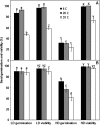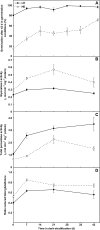Selection for low or high primary dormancy in Lolium rigidum Gaud seeds results in constitutive differences in stress protein expression and peroxidase activity
- PMID: 20974739
- PMCID: PMC3022398
- DOI: 10.1093/jxb/erq334
Selection for low or high primary dormancy in Lolium rigidum Gaud seeds results in constitutive differences in stress protein expression and peroxidase activity
Abstract
Seed dormancy in wild Lolium rigidum Gaud (annual ryegrass) populations is highly variable and not well characterized at the biochemical level. To identify some of the determinants of dormancy level in these seeds, the proteomes of subpopulations selected for low and high levels of primary dormancy were compared by two-dimensional polyacrylamide gel electrophoresis of extracts from mature, dry seeds. High-dormancy seeds showed higher expression of small heat shock proteins, enolase, and glyoxalase I than the low-dormancy seeds. The functional relevance of these differences in protein expression was confirmed by the fact that high-dormancy seeds were more tolerant to high temperatures imposed at imbibition and had consistently higher glyoxalase I activity over 0-42 d dark stratification. Higher expression of a putative glutathione peroxidase in low-dormancy seeds was not accompanied by higher activity, but these seeds had a slightly more oxidized glutathione pool and higher total peroxidase activity. Overall, these biochemical and physiological differences suggest that L. rigidum seeds selected for low dormancy are more prepared for rapid germination via peroxidase-mediated cell wall weakening, whilst seeds selected for high dormancy are constitutively prepared to survive environmental stresses, even in the absence of stress during seed development.
Figures





Similar articles
-
Selection for low dormancy in annual ryegrass (Lolium rigidum) seeds results in high constitutive expression of a glucose-responsive α-amylase isoform.Ann Bot. 2012 Dec;110(8):1641-50. doi: 10.1093/aob/mcs213. Epub 2012 Sep 21. Ann Bot. 2012. PMID: 23002268 Free PMC article.
-
Initial characterisation of low and high seed dormancy populations of Lolium rigidum produced by repeated selection.J Plant Physiol. 2010 Oct 15;167(15):1282-8. doi: 10.1016/j.jplph.2010.04.004. Epub 2010 May 15. J Plant Physiol. 2010. PMID: 20478642
-
Dark-mediated dormancy release in stratified Lolium rigidum seeds is associated with higher activities of cell wall-modifying enzymes and an apparent increase in gibberellin sensitivity.J Plant Physiol. 2011 Apr 15;168(6):527-33. doi: 10.1016/j.jplph.2010.09.001. Epub 2010 Sep 25. J Plant Physiol. 2011. PMID: 20870311
-
Primary seed dormancy: a temporally multilayered riddle waiting to be unlocked.J Exp Bot. 2017 Feb 1;68(4):857-869. doi: 10.1093/jxb/erw377. J Exp Bot. 2017. PMID: 27729475 Review.
-
Seed dormancy and germination.Curr Opin Plant Biol. 2002 Feb;5(1):33-6. doi: 10.1016/s1369-5266(01)00219-9. Curr Opin Plant Biol. 2002. PMID: 11788305 Review.
Cited by
-
The role of glyoxalases for sugar stress and aging, with relevance for dyskinesia, anxiety, dementia and Parkinson's disease.Aging (Albany NY). 2011 Jan;3(1):5-9. doi: 10.18632/aging.100258. Aging (Albany NY). 2011. PMID: 21248374 Free PMC article. No abstract available.
-
Cytological and Proteomic Analyses of Osmunda cinnamomea Germinating Spores Reveal Characteristics of Fern Spore Germination and Rhizoid Tip Growth.Mol Cell Proteomics. 2015 Sep;14(9):2510-34. doi: 10.1074/mcp.M114.047225. Epub 2015 Jun 19. Mol Cell Proteomics. 2015. PMID: 26091698 Free PMC article.
-
Comparative proteomics and gene expression analyses revealed responsive proteins and mechanisms for salt tolerance in chickpea genotypes.BMC Plant Biol. 2019 Jul 9;19(1):300. doi: 10.1186/s12870-019-1793-z. BMC Plant Biol. 2019. PMID: 31288738 Free PMC article.
-
Proteomic responses to progressive dehydration stress in leaves of chickpea seedlings.BMC Genomics. 2020 Jul 29;21(1):523. doi: 10.1186/s12864-020-06930-2. BMC Genomics. 2020. PMID: 32727351 Free PMC article.
-
Gibberellin-like effects of KAR1 on dormancy release of Avena fatua caryopses include participation of non-enzymatic antioxidants and cell cycle activation in embryos.Planta. 2016 Feb;243(2):531-48. doi: 10.1007/s00425-015-2422-1. Epub 2015 Nov 2. Planta. 2016. PMID: 26526413 Free PMC article.
References
-
- Bailly C. Active oxygen species and antioxidants in seed biology. Seed Science Research. 2004;14:93–107.
-
- Beers RF, Sizer IW. A spectrophotometric method for measuring the breakdown of hydrogen peroxide by catalase. Journal of Biological Chemistry. 1952;195:133–140. - PubMed
-
- Bettey M, Finch-Savage WE. Stress protein content of mature Brassica seeds and their germination performance. Seed Science Research. 1998;8:347–355.
-
- Bielawski W, Joy KW. Properties of glutathione reductase from chloroplasts and roots of pea. Phytochemistry. 1986;25:2261–2265.
-
- Bradford MM. A rapid and sensitive method for the quantitation of microgram quantities of protein utilizing the principle of protein–dye binding. Analytical Biochemistry. 1976;72:248–254. - PubMed

